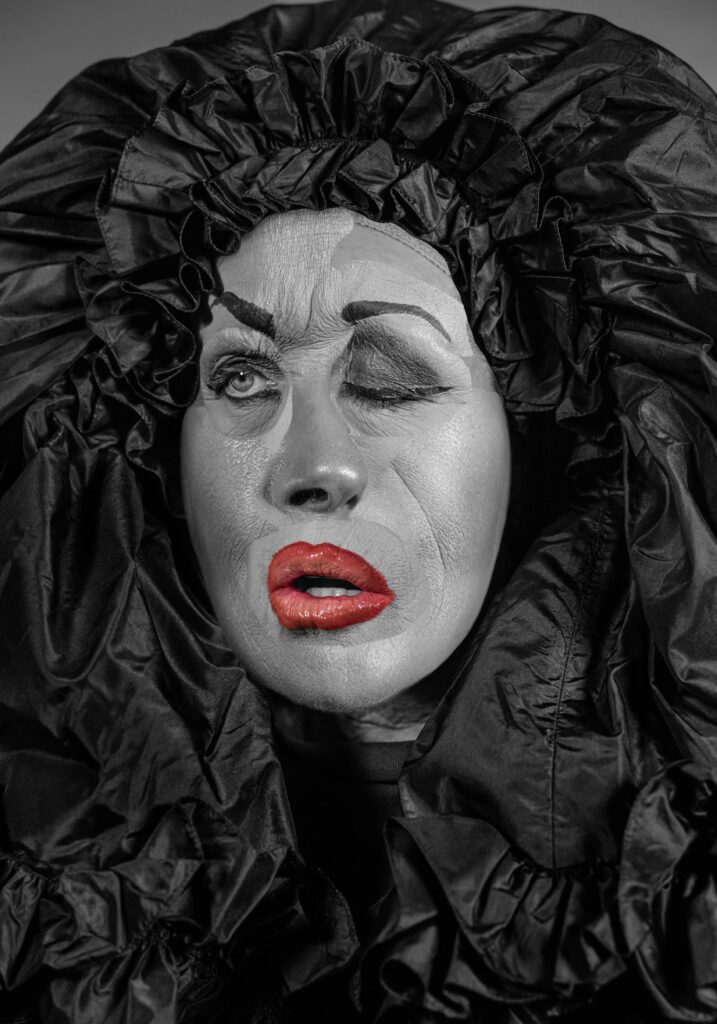Cindy Sherman, Who Built a Career Out of Being Someone Else, Goes Beyond Portraiture Into Digital Collage
The artist pushes the possible iterations of identity in ways that provoke and amplify our malaise surrounding it.

Cindy Sherman
Hauser & Wirth, 134 Wooster Street, New York, NY
January 18 – March 16, 2024
Walking through the slushy New York streets over the last week, a bit of sandwich-board wisdom struck me as wise: “I went to Los Angeles to Find Myself. I came to New York City to Be Someone.”
In a stellar New York Art career spanning four decades, Cindy Sherman has had little interest in finding herself, but has been very busy being someone. Rather, she has built a career out of being someone else.
Using disguise, artifice, costumes, and props, she has photographed herself as a cast of cinematic and increasingly outlandish characters for over four decades. You never know who she might be next.
Ms. Sherman began shooting herself as a heroine in fictional film stills in the mid-seventies, taking punk rock nostalgia for earlier eras to an abstruse, unprecedented level. She specialized in Hitchcockian tableaux where she often appeared as the beleaguered ingenue or vamp.

The stills were striking in their incredibly fine-grained attention to cinematic detail, and her chameleon-like ability to shift her appearance. They did nothing, however, to dispel the underlying anxiety they provoked.
Ms. Sherman couldn’t have arrived at a better moment. North America had reached peak simulacrum, a time when pop culture began to glitch in its cyclical feedings and re feedings upon itself.
She was both provoking and riding a wave: the same moment when Quentin Tarantino re-invented cinema by going farther into cinematic nostalgia. It was a moment, in other words, when quoting and referencing pop culture became the culture.
She was also a feminist artist, but in a completely different way than her Sixties progenitors. Unlike Carolee Schneeman or Hannah Wilkes before her, who often showed overmuch of themselves in a bid to undermine the patriarchy, Ms. Sherman arrived ready to play dress up. She explores the feminine not as an archetypal essence, but rather as an ever complexifying hall of mirrors.
In this latest series of images by Ms. Sherman for Hauser & Wirth’s new Wooster Street location, Ms. Sherman uses digital techniques to turn herself into a virtual Mrs. Potato head.
She collages eyes, nose lips and other facial elements onto her visage in much the same way she has used prosthetics in the past. The effect is striking, if not downright freakish at times.
It has always been difficult to fathom what Ms. Sherman is aiming at, especially when she strains her appearance in new and uncomfortable directions. One is often prompted to ask “Where is she taking us?”
Ms. Sherman, though, has never been diagnostic, and she is not interested in curing the ennui surrounding identity. Rather, she pushes the possible iterations of identity in ways that provoke and amplify our malaise surrounding it.
She has always depicted the dysphoria inherent in identity, the tensions within appearance and the self that seem to have no resolution. There are no titles for this photographic series, only numbers, catalogue entries in her already vast catalogue of augmented characters.
As unsettled as these images are, going beyond beyond portraiture into straight digital collage, or simulacra upon simulacra, it’s a wonder is that any unified emotional reading of them is possible at all.
And yet, Ms. Sherman delivers. “Untitled #629” seems to express nothing but sheer angst. With its tiny eyes set slightly too far apart, wrinkled forehead and wide rictus of a mouth, the whole visage appears to be drowning in terror.
Is it the anxiety of advancing years, the concern that mortality lurks nearer and nearer? She leaves us to figure it out. “Untitled #646” appears to be a fairy tale creature with a fur hood, looking heroically over its shoulder. Where is it going, what storybook dimension does it inhabit? We’ll never know.
“Untitled #654,” with its dark ruff of black satin, has all the punch of a Goya portrait, but appears to be a riff on cubist portraiture. “Untitled #650” appears to be a half sneering trailer park denizen or, given the snake like tendrils of her hair, a rural medusa. It all works through reference and half reference, surmises and feints, a digital morass of visual cues that nonetheless contains sharp and salient points of recognition.
Ms. Sherman has always been the master of narrative shorthand, the ability to convey a convincing fragment of narrative with a single image. However distorted or confounding the image, you are compelled to attempt a reading of it.
I think this is because their identitarian slipperiness leaves you fumbling with a barrage of assumptions. In the end, I think this is the point. Ms. Sherman’s work exists to help us catch ourselves in the middle of our presumptions surrounding identity, and to see how baffling and confounding they often are.

